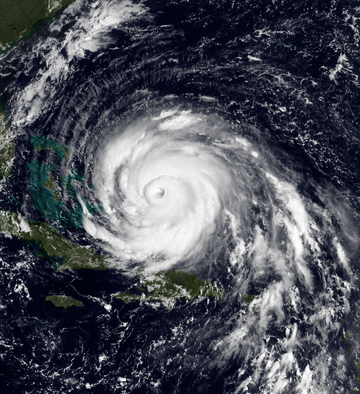Hurricane Floyd facts for kids
| Category 4 major hurricane (SSHWS/NWS) | |

Hurricane Floyd at peak intensity on September 13 north of the Dominican Republic
|
|
| Formed | September 7, 1999 |
|---|---|
| Dissipated | September 19, 1999 |
| Highest winds | 1-minute sustained: 155 mph (250 km/h) |
| Lowest pressure | 921 mbar (hPa); 27.2 inHg |
| Fatalities | 57 direct, 20–30 indirect |
| Damage | $4.5 billion (1999 USD) |
| Areas affected | The Bahamas, U.S. East Coast from Florida to Maine (particularly North Carolina), Atlantic Canada |
| Part of the 1999 Atlantic hurricane season | |
Hurricane Floyd was a very powerful and damaging storm that hit in 1999. It was the strongest, most expensive, and deadliest hurricane of the 1999 Atlantic hurricane season. At first, it looked like Hurricane Floyd was heading straight for Florida. It was a huge storm, about twice the size of Hurricane Andrew, which had caused a lot of damage before. If Floyd had hit Florida, it could have been even worse than Andrew.
But instead of Florida, Hurricane Floyd turned and struck North Carolina. It caused a lot of flooding from North Carolina all the way up to some states in New England. The storm left about $4.5 billion in damage across many states, from Florida to Maine. Sadly, Hurricane Floyd also caused the deaths of about 76 to 86 people in the United States. One person also died in The Bahamas.
Retirement of the Name Floyd
When a hurricane causes a lot of damage or deaths, its name is often "retired." This means the name won't be used again for another storm. The name Floyd was retired in the spring of 2000 because of how much destruction it caused. A new name, Franklin, was used instead in 2005 for a different storm.
|
Tropical cyclones of the 1999 Atlantic hurricane season |
||||||||||||||||||||||||||||||||
|
|
|||||||||||||||||||||||||||||||
|
|
||||||||||||||||||||||||||||||||
Images for kids
-
Visual comparison of Hurricane Floyd with Hurricane Andrew. They are shown at similar spots and strengths.
-
People evacuating on Interstate 26 to escape the storm.
-
Damage to buildings near the coast at Pine Knoll Shores, North Carolina.
-
Flooding in Greenville, North Carolina along the Tar River.
See also
 In Spanish: Huracán Floyd para niños
In Spanish: Huracán Floyd para niños










